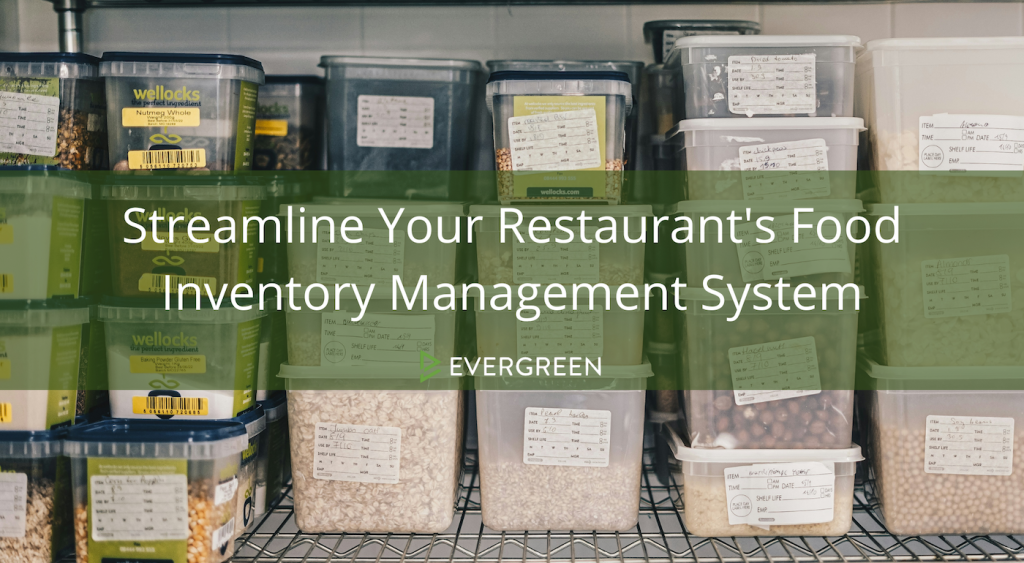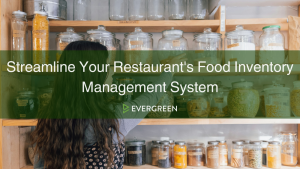Streamline Your Restaurant’s Food Inventory Management System

Efficient food inventory management is crucial for the success of any restaurant. By streamlining your inventory system, you can reduce costs, prevent food waste, improve order accuracy, and ensure that your restaurant is always well-stocked with fresh ingredients.
In this blog post, we’ll explore the importance of efficient inventory management, identify the challenges in your current system, discuss strategies for improvement, and provide tips for training your staff. Let’s dive in!
Understanding the Importance of Efficient Inventory Management
Effective inventory management is the backbone of any successful restaurant operation. It involves tracking and controlling the flow of food items in and out of your establishment. Proper inventory management ensures that you have the right amount of ingredients on hand, minimizing waste and maximizing profitability.
But what exactly does efficient inventory management entail? Let’s delve deeper into the topic to understand its significance.
The Role of Inventory Management in Restaurants
Inventory management plays a vital role in ensuring that your restaurant can meet customer demand while avoiding stockouts or overstocking. It allows you to forecast demand accurately, plan menu offerings, and maintain consistent food quality.
By keeping track of your inventory, you can identify which items sell well and which ones need to be reevaluated. This knowledge helps optimize your menu and purchasing decisions.
Imagine a scenario where a popular dish on your menu suddenly becomes a customer favorite. Without efficient inventory management, you might run out of key ingredients, disappointing customers and potentially losing out on sales. On the other hand, if you overstock on ingredients that are not in high demand, you risk incurring unnecessary costs and increasing the chances of food waste.
Benefits of Streamlining Your Inventory System
Streamlining your restaurant’s inventory system comes with numerous benefits:
- It saves you time by simplifying the ordering process. You can easily identify what items need to be restocked and place orders accordingly. With a well-organized inventory system, you can avoid the hassle of manually counting items or searching through shelves to find what you need.
- Streamlining reduces food waste as you can track expiry dates, implement first-in, first-out (FIFO) practices, and minimize overstocking. By monitoring the shelf life of your ingredients, you can ensure that you use them before they expire, reducing the chances of throwing away unused or spoiled food.
- It improves order accuracy, ensuring that you receive the right items in the right quantities from your suppliers. By having a clear understanding of your inventory levels, you can communicate effectively with your suppliers, reducing the chances of receiving incorrect or excessive orders. This not only saves you money but also strengthens your relationships with suppliers, leading to smoother operations.
By having an efficient inventory system, you can significantly reduce costs associated with food waste and unnecessary purchases, ultimately increasing your profit margins. Moreover, it allows you to focus on other aspects of your restaurant, such as enhancing customer experience and improving overall efficiency.
Efficient inventory management is crucial for the success of any restaurant. It enables you to meet customer demand, minimize waste, and make informed purchasing decisions. By streamlining your inventory system, you can save time, reduce food waste, and improve order accuracy. Investing in efficient inventory management not only benefits your bottom line but also enhances the overall operations of your restaurant.
Identifying Challenges in Your Current Inventory System
Before you can improve your restaurant’s inventory management, it’s essential to identify the challenges you are facing with your current system.
Managing inventory in a restaurant can be a complex task, as it involves juggling various factors such as menu variety, customer traffic, peak hours, and storage space limitations. In order to streamline this process and ensure efficient operations, it is crucial to address the common challenges that often arise in restaurant inventory management.
4 Common Inventory Management Issues in Restaurants
- One of the most prevalent challenges faced by restaurant owners is inaccurate forecasting. Without accurate predictions of demand, it becomes difficult to maintain optimal stock levels, leading to overstocking or stockouts. This not only ties up valuable capital but also results in increased food waste and decreased customer satisfaction due to menu item unavailability.
- In addition to forecasting issues, manual data entry errors can also plague restaurant inventory management systems. With multiple staff members responsible for recording inventory data, the chances of human error are high. These errors can lead to discrepancies in stock levels, making it challenging to track inventory accurately.
- Another common challenge is the lack of communication between the kitchen and front-of-house staff. When there is a disconnect between these two crucial departments, it becomes difficult to coordinate inventory needs. This can result in miscommunication, leading to over or under-ordering of ingredients, which in turn affects the overall efficiency of the restaurant.
- Furthermore, many restaurant owners and staff may lack sufficient knowledge of inventory software. This can hinder the effective utilization of inventory management tools and technologies. Without a thorough understanding of the software’s capabilities, restaurant owners may not be able to leverage its full potential, resulting in suboptimal inventory management practices.
Assessing Your Restaurant’s Inventory Needs
To overcome these challenges, it is essential to start by assessing the specific needs of your restaurant. If your restaurant offers a wide range of menu items, you may need to maintain a larger inventory to accommodate the diverse ingredients required. On the other hand, if your establishment experiences high customer traffic during specific hours, you may need to implement inventory management strategies that ensure sufficient stock levels during peak periods.
Additionally, evaluating your storage space limitations is crucial in determining the feasibility of certain inventory management practices. If your restaurant has limited storage space, you may need to explore alternative solutions such as just-in-time ordering or off-site storage options.
By conducting a thorough assessment of your restaurant’s inventory needs, you can gain valuable insights into the specific challenges you face. Armed with this knowledge, you can then proceed to implement targeted strategies and technologies that will optimize your inventory management practices and enhance overall operational efficiency.
4 Strategies for Streamlining Your Inventory Management
Now that you understand the importance of efficient inventory management and have identified challenges in your current system, it’s time to implement strategies for improvement.
1. Implementing a First-In, First-Out (FIFO) System
One effective strategy is to implement a first-in, first-out (FIFO) system. The FIFO strategy guarantees old or soon-to-expire items are used before newly-ordered ones, eliminating waste at the time and place it’s most likely to occur. Train your staff to rotate items properly, placing newer stock at the back and using older stock first.
By implementing a FIFO system, you not only reduce the chances of food spoilage, but you also improve the overall quality of your products. This is particularly important in the food industry, where freshness and taste are key factors in customer satisfaction.
The FIFO approach also helps you optimize your inventory turnover rate. By using older stock first, you can prevent items from sitting on the shelves for too long, ensuring that you always have fresh and in-demand products available for your customers.
2. Leveraging Technology for Inventory Management
Technology can greatly simplify and enhance your inventory management process. Invest in a robust inventory management software that integrates with your POS system. This allows real-time tracking of sales, ingredient usage, and inventory levels. With automated data entry and accurate reporting, you can make informed decisions about purchasing, menu planning, and pricing.
With the right inventory management software, you can streamline your operations by automating various tasks. Useful inventory software automatically generates purchase orders when inventory levels reach a certain threshold, ensuring that you never run out of essential items. It can also provide insights into your best-selling products, allowing you to optimize your menu and focus on items that generate the most revenue.
Additionally, consider using barcode scanners and mobile devices for stocktaking, reducing errors and saving time compared to manual data entry. Barcode scanners allow for quick and accurate scanning of product codes, eliminating the need for manual counting and reducing the chances of human error. Mobile devices, equipped with inventory management apps, enable your staff to update inventory levels in real-time, ensuring that your records are always up to date.
By leveraging technology for inventory management, you not only improve the efficiency of your operations but also gain valuable insights into your business. With accurate and up-to-date data, you can make data-driven decisions that drive growth and profitability.
3. Training Your Staff for Effective Inventory Management
Even with the best inventory management system in place, staff involvement and proper training are crucial for success. In order to optimize your inventory management process, it is important to ensure that your staff is well-trained and actively engaged in the inventory management tasks.
4. Importance of Staff Involvement in Inventory Management
Make sure your staff understands the value of accurate inventory management and how it contributes to the overall success of the restaurant. When your staff is actively involved in the inventory management process, they become more aware of the importance of maintaining accurate stock levels and minimizing wastage. Encourage them to be proactive in reporting stock issues, such as low quantities or quality concerns, so that prompt action can be taken to address these issues.
Regularly communicate with your staff regarding inventory goals, expectations, and any updates or changes in procedures. By keeping them informed, you can ensure that everyone is on the same page and working towards the same objectives. This open line of communication also allows for feedback from your staff, which can be invaluable in identifying areas for improvement and implementing necessary changes.
Tips for Training Staff on New Inventory Systems
When implementing a new inventory system, it is essential to provide comprehensive training to your staff. Conduct workshops or training sessions to ensure they understand how to use the software, input data accurately, and perform inventory counts efficiently. This training should cover all aspects of the new system, including how to navigate through the software, how to input data correctly, and how to generate reports.
In addition to the initial training, make instructional materials available for reference. This can include user manuals, step-by-step guides, and video tutorials. Having these resources readily accessible allows your staff to refresh their knowledge and troubleshoot any issues they may encounter.
Always be happy and ready to provide ongoing feedback and support for your staff. Offer assistance whenever they face challenges or have questions about the new system.
Regularly review their performance and provide constructive feedback to help them improve their inventory management skills. By investing in their training and development, you are empowering your staff to become more proficient in inventory management, which ultimately benefits the overall efficiency and profitability of your restaurant.
Regularly Reviewing and Improving Your Inventory System
Regularly reviewing and improving your inventory system is crucial for maintaining an efficient and well-organized operation. It ensures that you have accurate stock levels, minimizes waste, and maximizes profitability. Let’s explore some additional details on how to achieve this.
Setting Up Regular Inventory Checks
Schedule regular inventory checks to assess stock levels, review expiration dates, and identify slow-moving items. This practice helps prevent overstocking and ensures that your inventory remains fresh and in-demand.
During these inventory checks, it’s important to have a systematic approach. Start by categorizing your inventory into different sections, such as perishable and non-perishable items. This way, you can prioritize items that require immediate attention.
Additionally, consider using inventory management software that can generate reports and provide real-time data on your stock levels. This will make the inventory check process more efficient and accurate.
Continual Improvement of Your Inventory Management System
Continually seek feedback from your staff, suppliers, and customers on how to improve your inventory management system. Their insights can provide valuable perspectives on areas that need improvement or potential opportunities for optimization.
Staying up-to-date with industry trends and technologies is crucial in identifying new tools and strategies that could further streamline your processes. For example, implementing barcode scanning systems can help automate inventory tracking and reduce human error.
Regularly attending industry conferences, workshops, and seminars can also expose you to the latest advancements in inventory management. Networking with other professionals in your field can provide valuable insights and best practices.
Remember that effective inventory management is an ongoing process that requires attention, communication, and adaptability. By implementing these strategies and investing in staff training, you can streamline your restaurant’s food inventory management system, reduce costs, and improve overall operational efficiency. Start today and reap the benefits tomorrow!
Want to put all of your inventory troubles behind you? Evergreen is your one-stop shop for all things var and restaurant inventory management. Book a demo now to see how your business can transform.


